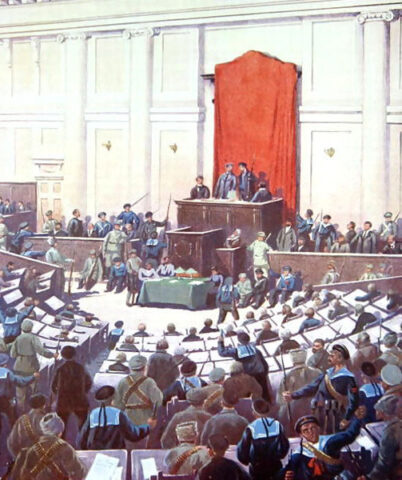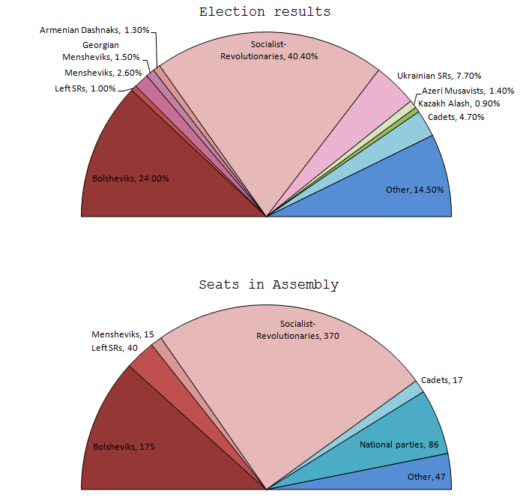
In the last years of tsarism, many Russians desired one political reform above all others: an elected legislature to represent their rights and interests. The dream of a democratic constituent assembly became a rallying point for reformists and radicals alike. It was supported by a broad spectrum of revolutionary groups. Octobrists, Kadets, SRs, Mensheviks, even moderate Bolsheviks all supported a future constituent assembly. The Russian people, it seemed, craved democracy and self-government more than they desired socialism. The formation of the Duma in 1906, its betrayal by the tsar and the Duma’s leadership during the February Revolution only increased their hunger for a constituent assembly. During the turmoil of 1917, the planned Constituent Assembly became a beacon of hope for the future. But the Bolshevik revolution of October 1917 raised questions about the Constituent Assembly and its role in the new society. Would the Bolsheviks be willing to share power with an elected legislature containing non-Bolshevik voices? These questions were answered swiftly in January 1918, when Lenin shut down the Constituent Assembly after just one day. Russia’s hopes of democratic government were cast into oblivion.
These delays contributed to the Provisional Government’s growing unpopularity – not to mention rumours and conspiracy theories suggesting the government intended to cancel or ‘rig’ the Constituent Assembly. The radical wing of the Bolshevik movement cashed in by accusing Kerensky of sabotaging the elections and insisting that responsibility for the assembly be handed to the Soviets. For their part, the Bolsheviks promised to support the assembly, provided it acted decisively on some key issues. “The Constituent Assembly… must decide questions of land reform, of the war and of all the wealth of the nation”, said one Bolshevik report. “The Constituent Assembly must right the historical wrongs… and protect the working class from exploitation.” On October 27th, two days after seizing power, Lenin announced that elections for the Constituent Assembly would be brought forward to November 12th. But the Bolshevik leader was also cautious about the “constitutional illusions” of the assembly, warning that placing too much faith in an elected parliament posed the risk of a liberal-bourgeois counter-revolution. One Bolshevik leader, Volodarsky, threatened a new revolution if the assembly did not protect class interests:
We place the whole question [of the Constituent Assembly] on a revolutionary class platform. The soldiers and peasants must perceive that life can be given to the revolution only if our party secures a majority. The masses have never suffered from parliamentary cretinism. If the Constituent Assembly should oppose the will of the people, the question of a new uprising will arise. We do not have a Constituent Assembly fetish. There might arise a situation where we would oppose the Constituent Assembly, along with the Soviets.

Elections for the Constituent Assembly proceeded in late November but failed to produce a Bolshevik majority. The Socialist-Revolutionaries – the party of land reform and the peasants – achieved a small majority, winning 370 of the 715 seats. In contrast, the Bolsheviks won 175 seats, just under one-quarter of the assembly. Breakdowns of voting patterns provide a clear picture of Bolshevik electoral support. They were the most popular party in industrial cities like Petrograd (winning 43 per cent of the vote) and Moscow (46 per cent). The Bolsheviks also polled well among soldiers, winning more than three-fifths of the vote in most divisions of the army. But outside the military and the large industrial city, support for the Bolsheviks dwindled. In some rural and provincial areas, their percentage share of the vote failed to reach double figures.

Whatever their reasons, these electoral outcomes produced a pivotal shift in Bolshevik attitudes towards the Constituent Assembly. Having spent weeks tentatively defending it, Bolsheviks now began to question the assembly’s legitimacy and attack those elected to fill its seats. Lenin condemned the assembly as unrepresentative and skewed; he claimed that the SR party had split and therefore could not command a voting majority. The two weeks between the election and the scheduled convocation of the assembly (November 28th) were filled with rumours about what the Bolsheviks might do. They arrested members of the electoral commission and replaced them with Uritsky, a loyal Bolshevik and future CHEKA boss. Days before the scheduled opening the Bolsheviks placed the naval garrison at Kronstadt on alert. It began to look as if the military suppression of the assembly was imminent. On the morning of November 28th, Sovnarkom ordered the arrest of Kadet deputies to the assembly and postponed the assembly’s first sitting until early in 1918, citing “unpreparedness”.
“In the days before [the October Revolution], the Bolsheviks launched many attacks against the Provisional Government for its delay in calling a Constituent Assembly. They recognised the wide popularity of this project of a national democratic parliament to settle the form of government and also the many political and social problems of which the revolution was an expression. They advocated the assembly largely as a matter of tactics.,. But after the Bolshevik seizure of power and the formation of a Soviet government with the Bolsheviks in control, the tactical situation was radically altered. The Constituent Assembly could no longer be used against their opponents; on the contrary, it became the rallying cry of those who aimed to end the dictatorship.”
James Bunyan, historian
The public response to the closure of the Constituent Assembly was relatively subdued. Some of the ousted deputies called on the people of Petrograd to rise up and defend the assembly. But the workers, it seemed, were content enough to allow the government to remain in the hands of the Soviets. The peasants were also largely indifferent to the fate of the assembly. Few seemed surprised that the Bolsheviks had taken this course; it was more surprising that they had allowed the assembly to convene in the first place. In Britain and the United States, where Lenin was still considered a German agent, the dissolution of the Constituent Assembly was believed to have been orchestrated by Berlin. Meanwhile, several members of the dissolved assembly sought to keep it alive by meeting in secret in the suburbs of Petrograd – but this soon became too dangerous and ceased. Russia’s first real attempt at democratic representative government passed into history – and with this came the rise of the Bolshevik dictatorship.

1. The Constituent Assembly was a democratically-elected representative body formed in the wake of the February Revolution. The idea of a constituent assembly had long been supported by Russian reformists.
2. The task of organising elections for the Constituent Assembly fell to the Provisional Government, however, these elections were delayed by the war and the disruptions of 1917.
3. After seizing power in October 1917, the Bolsheviks allowed elections for the Constituent Assembly to proceed. These elections, held in November 1917, produced a sizeable majority for the Socialist Revolutionaries (SRs).
4. With the Bolsheviks now confronted by an elected legislature dominated by a non-Bolshevik party, Lenin condemned the assembly as unrepresentative and counter-revolutionary and threatened to dissolve it.
5. The Constituent Assembly met in January 1918. Its first actions were to elect an SR chairman and refuse ratification for earlier Bolshevik decrees. The assembly sat for just one day before Lenin’s Red Guards dissolved it, on his orders.
© Alpha History 2018. Content on this page may not be republished or distributed without permission. For more information please refer to our Terms of Use.
This page was written by Jennifer Llewellyn, John Rae and Steve Thompson. To reference this page, use the following citation:
J. Llewellyn et al, “The Constituent Assembly” at Alpha History, https://alphahistory.com/russianrevolution/constituent-assembly/, 2018, accessed [date of last access].
